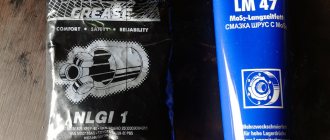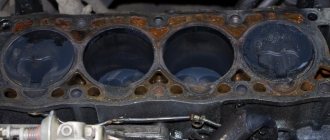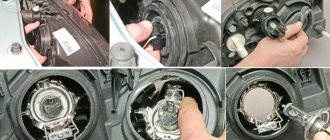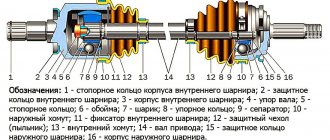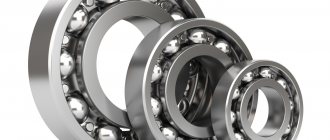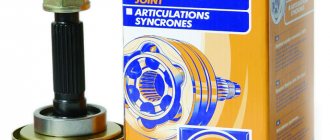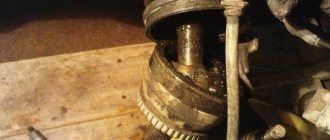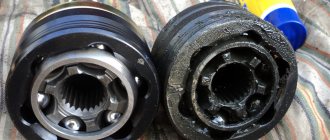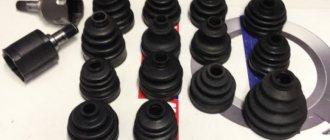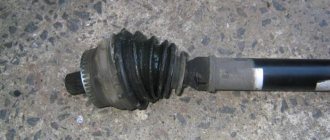The grenade or constant velocity joint (CV joint) is an important functional unit that is impossible to do without in front-wheel drive cars. Previously, I did not think that the CV joint was very susceptible to breakdowns and periodically forgot to carry out maintenance of this mechanism, until the sad end of my carelessness came. In general, at that time I was still young and just starting to repair cars, so I turned to my colleague, a more experienced master, for advice.
As I was told, this mechanism is very subject to serious loads, so for normal operation it is necessary to regularly service it and, importantly, lubricate it with the “correct” composition. It turned out that choosing a lubricant for a CV joint and determining which one is better is not so easy.
When I took a closer look at this issue, it turned out that some compositions have their own advantages, others have their own, but there was still no universal substance until I solved the problem differently. In general, the review will talk about what is included in CV joint lubricants, which brands and types of mixtures are of better quality, and which ones should be abandoned. If you have questions on the topic, feel free to ask them in the comments. I will help in any way I can.
Why lubricate the CV joint?
A competent motorist will not ask such questions, since he already knows the answer. The situation is completely different with novice drivers and mechanics. To help, it’s worth talking in more detail about how CV joints benefit from lubrication. We are talking about the following points:
- prevents premature wear of parts that are constantly under load and subject to friction;
- the substance can reduce the load on other components due to the fact that the parts can rotate freely;
- there is a reduction in fuel consumption and a reduction in vehicle transmission losses;
- the lubricating mass prevents corrosion from penetrating into the mechanism.
In addition to these functions, the lubricant itself has a lot of advantages, but it is important to choose the right product. You should choose substances that do not harm organics and synthetic polymers, since anthers and other parts are often made of rubber or plastic. It is extremely important that the lubricating mass does not dissolve these elements.
Barium
Recently, such CV joint lubricant has been in increasing demand on the market. The progressive composition allows you to extend the service life of the hinge, as well as protect it from a number of negative influences. The main advantage here is that the substance is not at all afraid of moisture.
Thus, if the boot ruptures, there is no need to change the substance. In addition, the lubricant has excellent corrosion resistance and is also suitable for use even in fairly aggressive conditions. The composition is chemically neutral, so the anthers will not be damaged, regardless of the material of the seals.
The main disadvantage of such a substance is its relatively high price, which is caused by the complexity of the production process. We produce only ShRB-4 lubricant; everything else has to be purchased in other countries.
Main characteristics of the lubricant composition
Since it is important for many motorists that the lubricant performs all its stated functions, manufacturers are trying to develop formulations whose characteristics allow this to be done. If you try to list the parameters that such products have, you will get the following list:
- wide range of temperatures during use - up to 100 degrees Celsius, and sometimes more;
- ensuring strong adhesion to the surface, in other words, the lubricant is very sticky;
- excellent anti-scuff properties. The composition ensures normal sliding of the part over a long period;
- stability in mechanical, physical and chemical terms. It is extremely important for manufacturers that the lubricant retains its properties regardless of the external environment and loads.
All these parameters characterize the mixtures as high-quality and highly functional compositions. The products have good technical characteristics. parameters due to its unique composition. It should be noted here that products from different brands may have different compositions. Some details about CV joint lubricants can be found in the video:
What is a CV joint, its functions and types?
CV joints are called constant velocity , which are used to ensure uninterrupted transmission of rotational motion from the gearbox and gearbox to the wheels at a constant speed. Their work occurs regardless of the angle of rotation, as well as the suspension or transmission. The design of these parts consists of external (fixed in the wheel hub) and internal (located in the transmission) hinges mounted on the axle shaft.
There are four types of CV joints:
- Ball CV joints are elements that transmit rotation using balls located in small grooves in body . They are mainly installed in front-wheel drive vehicles as an external wheel joint to provide high torque, as well as minimal play between the component elements. However, it must be taken into account that due to the special design of the ball CV joint, the axial movements of the suspension and transmission components are compensated not by it, but by other devices.
- Tripod elements are the most common type of CV joint that compensates for axial movements. A three-beam fork with rollers on needle bearings moving along guide grooves is fixed in the body of the structure. The tripod is used as internal wheel drive joints.
- Cam joints - these are usually installed in trucks. This is due to the fact that they have a low angular rotation speed, due to which the components are protected from overheating.
- Twin driveshafts are two connected joints used to compensate for uneven rotation of the balls. This type is installed in special equipment, as well as some models of trucks.
Regardless of the type of CV joint, the lubricant must be of good quality and changed in a timely manner. The appropriate product should be selected taking into account the type of components and technical characteristics of the vehicle in which they are used. Otherwise, used will be ineffective in reducing the friction force between parts.
Properties of lubricants for constant velocity joints
The composition of the CV joint lubricant is designed taking into account the difficult operating conditions of the joints, which makes it possible to provide reliable protection of the mechanism from the effects of various negative factors, as well as rapid wear. Due to their special properties, these products are used for the following purposes:
- increasing the friction coefficient of internal components;
- significant reduction in mechanical load on all components of the structure;
- slowing down the wear of individual hinge elements;
- increasing the protection of the surface of metal elements from corrosion destruction;
- ensuring a neutral reaction with different rubber hinge seals to protect the unit from damage;
- providing a water-repellent effect;
- extending the service life of the structure.
In this regard, a lubricant for external and internal hinges must have the following characteristics:
- Wide range of operating temperatures - from -40°C to +140°C and above, depending on the specific brand and article number . This property allows the composition to be used even in critical conditions without losing the effectiveness of protecting connections from loads.
- Increased degree of adhesion - the substance adheres well to the working surface of the device.
- High anti-scuff properties - due to this, an optimal level of sliding of the working surfaces is maintained.
- Physico-chemical, as well as mechanical stability of the product - these properties provide the same characteristics of the composition, regardless of the conditions of use.
To ensure safe and efficient operation of vehicles, CV joint lubricant must fully comply with the above requirements in terms of characteristics.
The most popular types of CV joint lubricants
Currently, a significant range of lubricants for grenades is presented on the world and domestic markets. All types of lubricating compounds can be divided into three groups, taking into account what is included in the product. Let's make a table.
| Options | Molybdenum | Lithium | Barium |
| general description | A more profitable option than lithium, since it is based on molybdenum disulfide. They have high anti-corrosion properties. The product is safe for rubber and polymers. | It is based on a lithium solution and organic acid. They appeared immediately after the development of CV joints. Allows you to reduce the load on the elements of the mechanism. Does not allow dirt and dust to penetrate inside. | Recently they have been in demand because they help extend the life of the hinge and protect it from negative influences. The composition is not afraid of moisture and resists corrosion. Chemically neutral. |
| Lifetime | Designed for 100-110 thousand km. mileage | Designed for 100 thousand cm of mileage. | Can be operated for 80-100 km. mileage |
| Flaws | Low resistance to moisture. As a result of water penetration, it turns into an abrasive. | In winter, it is difficult to smear because it thickens noticeably at low temperatures. | Does not withstand high temperatures well. It is distinguished by its high cost (415 rubles for 400 ml), since only one composition of this type is produced in Russia. |
| Most Popular Brands |
|
|
|
To choose the appropriate lubricant option, you should carefully study the current proposals and focus on the technical features of the car and the operating features of the composition itself.
Properly lubricate the tripod joint
Despite the fact that the design of the tripoid hinge is based on the use of needle bearings, lubricating them with 158 grease, which is usually used for needle bearings, is strictly prohibited. The fact is that a lithium thickener is used for its manufacture, and it can work at a temperature no higher than 120 ○ C, and the temperature of the internal grenade reaches 160 ○ C. Since the lubricant for the internal grenade is quite liquid, it is better to pour it inside the boot installed on drive, and then assemble the tripoid. You need to fill in from 100 to 130 g of lubricant. More precisely, to the question, “how much?” the manufacturer will answer.
- What is the best way to lubricate CV joints?
- Choosing a lubricant for CV joints
- Lithium greases
- Barium lubricants
- Molybdenum disulfide based lubricants
- What lubricant should not be used?
- How often to change the lubricant
To ensure the transmission of torque at rotation angles of up to 70 degrees relative to the axis, constant velocity joints (CV joints) are used in the drive systems of the steered wheels.
What lubricants should you avoid?
There are several groups of lubricating compounds that are not recommended for use. Such mixtures include:
- graphite, which will lead to mechanism failure after 20-25 km. mileage;
- hydrocarbon, for example, technical petroleum jelly, since they do not protect against corrosion and allow moisture to penetrate inside;
- Consistent, containing sodium and potassium. Suitable for bearings and other moving joints;
- zinc, since they are based on iron and are contraindicated for lubrication of such components.
These points should also be taken into account when choosing a suitable product for lubricating the “grenade”.
Lubricant testing
The tests included the following checks:
- Rinse with water and protect the unit from penetration of this liquid into it.
- Fluidity when temperature rises to 180 ○ C.
- Lubricating properties.
- Resistance of the lubricating film to pressure.
- Wear of metals protected by lubricant.
Places during the testing process were not allocated to the competitors, they were simply graded, so you will have to determine which lubricant is better. Below are the results of testing of ball joint greases by one of the independent researchers.
The procedure for replacing the lubricant and how it should be done
Once the issue of choosing a suitable lubricant has been resolved, all that remains is to change the lubricant. It is worth emphasizing here that the procedure is very simple and even inexperienced drivers will be able to cope with this task.
You will need to perform the following manipulations:
- Disassemble the mechanism housing (a flathead screwdriver is suitable for this).
- Remove the seals and boot, and then check their condition. If these elements are damaged, then it is worth purchasing new ones.
- Remove and completely disassemble the internal parts.
- Wash the parts with gasoline or solvent to remove old lubricant.
- Place the new substance in the “glass”, and then place the tipod in it. Add lubricant until it fills the container as much as possible.
- Assemble the knot.
It is recommended to change the composition every 50-60 thousand km, but there are also compositions that are designed for 100 thousand km. Here you should follow the instructions. If the car has been in the garage for 9 months or rarely driven for 18 months, the lubricant should also be replaced.
How to replace grease in angular velocity joints
Even a not very qualified user can perform this work. At least, you don’t have to be a car mechanic who has undergone a long apprenticeship. The main thing is to do everything carefully and slowly. Try to remove the anthers without damage if they look undamaged.
The CV joint is removed completely, in the sequence of actions that is inherent in this particular car model; it is difficult to give specific recommendations here.
Remember the locations of the parts of each node. Place tags. It is advisable to place even balls from a ball joint in the same slot where each of them was located.
The lubricant in the drive is replaced:
In case of rupture or puncture of the boot.
In case of purchasing and installing a new hinge.
If the mileage has reached 100,000 kilometers , regardless of operating conditions (or rather, even if driving conditions were ideal, and even earlier on bad roads).
The articulated drive has been in operation for more than 5 years.
CV joint removal algorithm:
- Hub nut kickback
- Removing the balls
- Loosening the boot tie (inner CV joint)
- Bending the stand
- Removing a part
- Removing the retaining ring
How to remove the outer joint (adjacent to the hub)
- Apply force to push through the separator. If you don’t have enough physical strength, tap through the gasket. If it doesn’t work, the drive assembly is removed as is and clamped in a vice. To prevent metal scuffing, use copper or aluminum pads on the “lips” of the vice.
- Unlock the anthers by removing the clamps from them and being careful not to break the seal. The fact is that “original” anthers are always better than purchased ones when they are taken as spare parts. And only then, hitting with a hammer through a drift, they knock the hinge off the axle drive.
- Turn the inner ring with the separator until the holes in it become visible. In this case, you need to try to maintain the perpendicularity of the axes of symmetry between the housing and the separator.
- Using a slotted thin screwdriver, remove all the balls. Keep in mind that two of the six holes for the balls have some longitudinal groove, due to which the balls have a slight free movement. So, the separator needs to be rotated so that these holes are in close contact with the walls of the housing. After this, the separator along with the inner ring can be easily removed from there.
- Remove the balls , immediately wiping them dry to remove any grease, and place marks on them. Place the same marks in the cleaned grooves in the CV joint cage.
- Insert the inner ring into the cage and it will be oriented so that the elongated holes are pressed against the body. Rotate the ring so that the hole intended for the drive is oriented along the axis of the housing.
- To fill the CV joint with lubricant, it is more convenient to clamp it in a vice, oriented with the drive hole facing up. Squeeze the grease out of the tube until the excess creeps out of the loose joints. And if it is in a jar, place it in the hole, pressing it inside with any cylindrical-shaped object of suitable diameter, until the same signs appear as in the case of filling from a tube.
- Clean all joint components from old grease
- Rinse and dry , remove even the slightest traces of washing liquid.
- Inspect the parts to ensure their integrity.
- Place grease in glass.
- Lubricate the cages with fresh grease and insert the balls in the same places where they were.
- Insert the clip and fix the separator.
- Remove excess grease.
120 to 150 of lubricant goes into the outer joint . Internally, adjacent to the engine - from 100 to 130 grams.
Disassembling the inner hinge
- We disassemble the case
To do this, you need to remove two rolled locking rings from the body. The tools you need for this are a small slotted screwdriver and pliers.
- Removing the anthers
Before removal, they are carefully inspected (if there are oil leaks, the oil is wiped off with a dry cloth. If there is no damage to the boot, it is removed very carefully for the purpose of its further use. And if there is damage (and through) - then there is no need to stand on ceremony, this part of the boot can be repaired is not subject to.
- We get all the “stuffing” of the hinge by disassembling
The balls are removed from the cages or from the flow grooves, and the tripoid needle bearings are removed after removing the retaining ring.
- We wash the hinge parts
Remove old grease from the hinge and its parts using gasoline, diesel fuel or any similar solvent. Not only the moving parts are washed, but also the grooves and guides along which tripod rollers run or the support balls of ball CV joints roll, and any insides of the glasses. After complete cleaning of the old lubricant, the parts are wiped and/or dried so that the newly applied lubricant is not mixed with the remains of the washing fluid.
- Place some new lubricant in the glass
A certain maximum amount of lubricant is placed in different types of hinges; this value is different for different types of cars. But the first portion should be about 90 grams.
- Assembling the hinges
Assembly is carried out in the reverse order, the balls in ball CV joints are inserted into the cages intended for them, and the tripoid needle bearings are inserted into their seats. The entire structure is pushed into the glass, retaining rings are inserted (don’t forget to lubricate the grooves under them!), anthers are pushed in - old ones, if they are intact, or newly purchased ones, and are also secured with rings and clamps.
When reinstalling the boot, do not fill it with grease to capacity. This is fraught with rupture of its shell during movement - due to increased pressure. And before tightening the clamp securing the boot, lubricate the groove under the clamp ( you can use lithol-24 )
